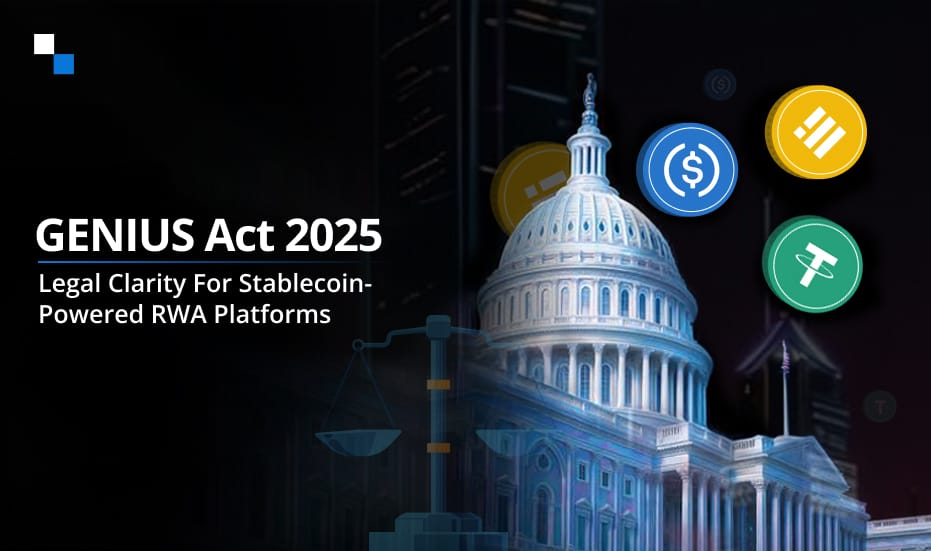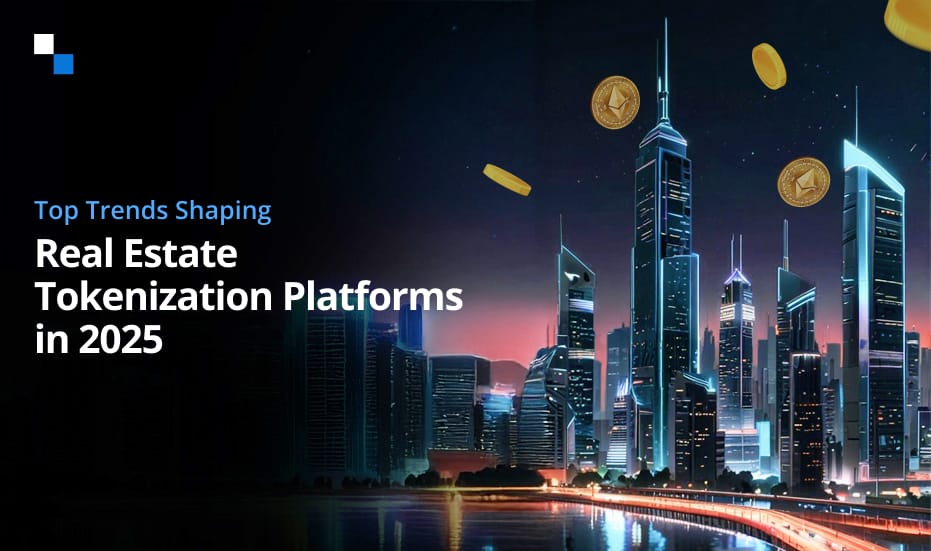
How to Stop Web3 Gaming Tokens from Dumping: Top Tactics
July 16, 2025
How to Launch an ICO That Raises Millions in Seconds
July 16, 2025Real-world asset Tokenization has evolved from theory to full-scale implementation. As of 2025, over $30 billion in RWAs are tokenized on Ethereum, while XRPL and Stellar are rapidly catching up with low-cost, regulation-ready infrastructure. BlackRock’s BUIDL fund, Franklin Templeton’s FOBXX, and Archax’s partnership with Ripple are now live, functioning examples of RWA tokenization at scale. But every blockchain has its strengths and trade-offs.
This guide compares Ethereum, XRPL, and Stellar for Real-world asset tokenization platform development in terms of cost, compliance, ecosystem, and technical readiness.
Asset Tokenization in 2025: Key Blockchain Insights & Network Dynamics
Ethereum, Stellar, and XRPL are serving as critical infrastructure for Real World Asset Tokenization Platform Development. Their growing support for compliance, cost-efficiency, and interoperability is driving large-scale adoption across financial institutions, asset managers, and regulated entities. Here are some key technical insights that are driving this adoption.
- Ethereum supports over $30 billion in tokenized RWAs, leveraging the compliance-ready ERC-3643 standard. The Dencun upgrade reduced gas fees by 95%, dramatically lowering transaction costs. This efficiency is a major catalyst for enterprise adoption and on-chain asset issuance.
- XRP Ledger (XRPL) recorded a good increase in tokenized asset volume within a single month, largely driven by the rise of tokenized U.S. treasuries. Ripple’s collaboration with regulated partners like Archax underscores XRPL’s growing role in institutional-grade asset tokenization.
- Stellar facilitated the tokenization of $446 million in U.S. treasuries through Franklin Templeton. Following the release of Protocol 23, Stellar’s native token XLM saw a 100% price increase, reflecting market confidence in its RWA roadmap. Stellar now targets $3 billion in tokenized assets on-chain by the end of 2025.

What Are Enterprises and Investors Looking For in 2025?
In 2025, the tokenization conversation has shifted from “why” to “how fast.” Institutional players and sophisticated investors aren’t just exploring blockchain, they’re deploying capital. But they’re selective. The platforms they back must offer more than just innovation; they need structure, security, and results.
Here’s what serious enterprises and investors prioritize in Asset tokenization platforms today:
1. Low Fees and Fast Settlement
Every second matters. High gas fees erode fractional ownership value and limit daily trading. Platforms built on chains like XRPL and Stellar, which offer sub-cent fees and 3–5 second finality, have a real edge in attracting volume-driven investors.
2. Built-in Compliance & Control
No one wants to code KYC from scratch. Enterprises prefer chains that offer protocol-level features, like freeze, clawback, and transfer restrictions. XRPL and Stellar provide native compliance tooling. Ethereum allows it, but at a much higher development cost.
3. Liquidity-Ready Infrastructure
Tokenizing an asset is only half the story. Can users buy, sell, and exit easily? The Real-World Asset Tokenization Platform must integrate AMMs, order books, and secondary market access, whether on-chain (like Stellar) or via regulated exchanges (like INX on Ethereum).
4. Regulatory Alignment
Platforms that can launch under known frameworks, like FIEA in Japan or FCA licensing in the UK, attract more trust and institutional capital. XRPL’s Archax integration and Stellar’s Franklin Templeton use case to prove that legal clarity now drives technical choice.
5. Token Standards with Role-Based Logic
Tokens must support role permissions, issuer, investor, custodian, and auditor out of the box. ERC‑3643 on Ethereum leads here, while XRPL and Stellar implement roles at the protocol layer for fast setup. Now let’s break down how Ethereum, XRPL, and Stellar compare, and which is best for your platform.
Ethereum vs XRPL vs Stellar: Detailed Analysis

Ethereum + ERC‑3643: Programmability Meets Compliance
Ethereum offers unmatched flexibility for building a real-world asset tokenization platform with its mature ecosystem, smart contract capabilities, and compliance-ready standards. ERC‑3643 (T-REX) brings built-in identity management and transfer controls, making Ethereum ideal for regulated asset platforms that also want full DeFi access.
ERC‑3643: A Developer-Ready Compliance Toolkit
ERC‑3643 (T-REX) supports:
- On-chain identity via ONCHAINID
- Rule-based transfer restrictions for jurisdictions, investors, and asset types.
- Upgradeable logic without losing DeFi compatibility.
Why Ethereum Works for Tokenization Platform Development
- Battle-tested infrastructure with Tokeny, Invesco, Citi, and others building on it.
- Access to Aave, Uniswap, Curve, and deep DeFi liquidity.
- Wide range of tools for custody, compliance modules, oracles, and audits.
- Active developer community and enterprise support.
Limitations To Consider:
- High L1 gas fees ($4–$5 per tx) impact UX.
- Low base-layer speed (~15 TPS).
- Requires Layer 2 integration (Polygon, Arbitrum), adds complexity in UX, and bridging.
Best Use Cases:
- Full-featured real-world asset tokenization platform with custom compliance rules.
- Projects needing DeFi integration, composability, or user programmability.
- Enterprises managing multi-layer architectures.
XRPL + Issuance Rules: Compliance Comes Standard
XRPL is purpose-built for platforms that need fast, low-cost, and compliant asset issuance, especially in regulated environments. With native tools for KYC, whitelist enforcement, and payments, XRPL is a strong choice for high-volume, low-complexity platforms like real estate-backed debt markets or tokenized bond systems.
XRPL’s Platform-Ready Features:
- Built-in KYC, whitelist controls, and issuer-level permission.
- Native path payments and on-chain exchange for liquidity.
- Protocol-level AMM to reduce slippage and increase price stability.
- 3–5 second finality with ~1,500 TPS.
Why XRPL Works for Tokenization Platform Development?
- No need to build compliance into smart contracts, as it is handled at the protocol level.
- Low-cost infrastructure with simple integration tools.
- Strong enterprise backing via the Ripple ecosystem.
- Actively used in projects like Mercado Bitcoin and Ondo Finance.
Limitations To Consider:
- No support for complex logic or EVM smart contracts.
- Limited flexibility if you need dynamic or programmable interactions.
- Less open-ended than Ethereum or Stellar with Soroban.
Best Use Cases:
- RWA Tokenization platforms focused on stablecoin settlements or bonds.
- Projects requiring KYC enforcement without smart contract management.
- Use cases that demand high throughput and low fees more than programmability.
Stellar + Soroban: Smart Contracts with Speed and Cost Efficiency
Stellar is built for platforms that prioritize speed, affordability, and basic programmability. With Soroban smart contracts now live, developers can add asset logic, automation, and integrations without giving up Stellar’s signature performance. Ideal for platforms issuing tokenized property shares or rental-backed assets.
Soroban: Making Stellar Platform-Friendly:
- Soroban enables smart contracts with fast execution and low overhead.
- Easy developer onboarding via CLI tools, SDKs, and modules.
- Built for tokenized payments, asset logic, and light automation.
Why Stellar Works for Tokenization Platform Development:
- Fast, affordable transactions (~$0.002) with 3,000 TPS capacity.
- Supported by enterprise players like Franklin Templeton and PayPal.
- Growing DeFi ecosystem with composable contracts and $100M+ TVL.
- Better suited for low-to-mid complexity RWA platforms.
Limitations To Consider:
- Soroban is a newer, smaller developer pool compared to Ethereum.
- Fewer pre-built integrations and less mature DeFi tooling.
- Not ideal for platforms needing deep DeFi access or custom compliance frameworks.
Best Use Cases:
- Real-world asset tokenization platform with simple investor logic or recurring payments.
- Projects focused on cross-border transactions or rental cash flow tokenization.
- Platforms that need cost-efficiency and moderate smart contract control

Case Studies: Live Real World Asset Tokenization Projects
Ethereum (ERC‑3643)
- Tokeny issues permissioned tokens with embedded KYC for real estate and private equity.
- DTCC has piloted on-chain securities using Ethereum, focusing on cross-jurisdictional clearing.
XRPL
- Mercado Bitcoin launched tokenized treasuries in Brazil with full regulatory compliance.
- Ondo Finance runs RLUSD on XRPL, linked to real-world bonds and dollar-pegged assets.
Stellar
- Franklin Templeton used Soroban to tokenize government bonds with automated compliance logic.
- PayPal’s PYUSD is reportedly deploying on Stellar for cross-border payments and liquidity.
Asset Tokenization Platform Development: Choose Your Blockchain Wisely
Choose Ethereum if:
- You need highly programmable tokens.
- Your use case integrates with DeFi.
- Compliance and investor verification are critical.
Choose XRPL if:
- You’re issuing high-volume, regulated assets like bonds or stablecoins.
- You want built-in compliance tools and low fees.
- Your project doesn’t require complex programmability.
Choose Stellar if:
- You want global-scale, fast settlement at a low cost.
- You’re building remittance or payment platforms.
- You prefer lightweight programmability for treasury or consumer-facing assets.

Plan To Successfully Launch Your RWA Tokenization Platform
1. Define Your Asset & Audience – Identify whether it’s bonds, real estate, funds, or treasuries.
2. Choose Your Chain – Balance liquidity, cost, compliance, and programmability.
3. Select Your Tech Stack
- Ethereum: ERC‑3643, audit-ready contracts
- XRPL: RippleX, KYC-native issuance
- Stellar: DIDs, Anchors, Soroban contracts
4. Integrate KYC & Custodial Services – Use trusted providers like Onfido, Chainalysis, or Taurus.
5. Build Issuance & Trading UX – Token minting, investor dashboard, and order book or AMM integration.
6. Pilot, Audit & Launch – Run compliance checks, optimize fees, and collect user feedback.
7. Scale Liquidity – List tokens on AMMs, exchanges, or regulated platforms.
Choose Strategically, Build Confidently
There’s no one-size-fits-all answer for choosing blockchain for a Real World Asset Tokenization Platform. Each protocol solves a different problem in the tokenization puzzle. The right choice depends on your asset class, transaction needs, and compliance obligations.
Partner with Antier for Real-World Asset Tokenization platform development, customized for Ethereum, XRPL, or Stellar. Get expert insights on choosing the ideal blockchain infrastructure for your next tokenization project. Whether you’re launching a regulated investment marketplace, tokenizing real-world assets, or bridging public and enterprise blockchains, our Asset Tokenization Platform Development Company can help you choose the right stack and get to market faster. Backed by real case studies, real results, and battle-tested tech.



